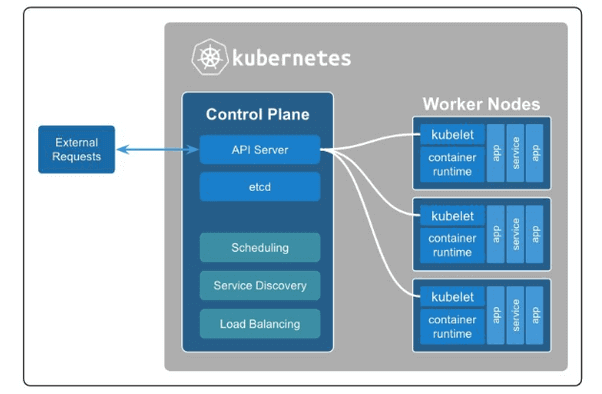
Kubernetes is a distributed, portable, extensible, open-source platform for container orchestration to manage apps, that built on multiple Runtimes. It has many services and tools.
The Relation between Google and Kubernetes
Kubernetes started life as a project inside Google and used Kubernetes as a container management Tool. Google released it in 2014 because default it has a Distributed Microservice design, which makes Google easy to run applications, in Cloud Environment.
To know more Data, Interact with our Expert by Kubernetes Online Training
Google adopts containers, microservices, and Kubernetes as driving users to its cloud services. Today, it managed and Developed by the Cloud Native Computing Foundation, which is a Linux Foundation.
Architecture
It was made by Master Node, which shows API, Timely Deployments, however, it handles the cluster, many worker nodes, are connected for Container Runtime.

Similar to Docker or rkt, with an operator that speaks with the master.
Master Components
These components contain the Master Node.
Kube-API server. showed the API.
Etcd. Key-esteem stores all cluster information.
Kube-scheduler. Set Alarm for new units on work Nodes.
Kube-controller-chief. Runs the controllers.
Cloud-controller-Manager. Communicate with cloud clients.
Kubernetes Terminology
Kubernetes "clusters" are made of "nodes." The term cluster shows the nodes in the total. "cluster" means to the whole running framework. A node is an operated machine inside it. A node might be a VM or a physical machine.
Generally, Every node has the software, to run containers handled by the Kubernetes control plane. The control plane is a combination of APIs and programming.
That clients connect with the control plane services run on the main nodes. As a matter of fact, Clusters may have so many guides for accessing high situations.
The control plane plan the container on nodes. In this specific term, the form "planning" doesn't showtime. Similarly, Consider it from a point of Kernal view.
The kernel "plans" the process on the CPU as referred by many elements. Certain procedures need more figures or have selected the nature of-service rules.
The scheduler does its best, to make sure, that each procedure gets CPU time. For this situation, planning Apply, selecting where to run containers as showed by factors like per-node tools requirements and the mentioned CPU/Memory.
Kubernetes Services
A Service in Kubernetes shows, how a given group of units, can be given by means of the system. As the Kubernetes report keep it, in the same fashion, the units that hold back-end apps may change. Yet the front-end shouldn't need to think about that or track them. Services may Reach.
Kubernetes Dashboard
This Dashboard guides, you to keep on the highest, point of different segments in Dashboard, in the same way, an online UI with which you can send and move applications and troubleshoot Cluster Data.
The dashboard isn't introduced as a matter of fact, including it, not a big Trouble.
Terms in Kubernetes
Master: The machine that manages Kubernetes nodes. Moreover, this is the place all work assignments begin.
Node: These machines operate on assigned works. As a matter of fact, the Kubernetes master controls them.
Pod: Generally, a group of one or many containers move to one node. All containers, in a pod, send an IP address, IPC, hostname, and different resources. In particular, Pods network and store away from the hidden container.
This gives you a chance to move containers around the group in a simple way.
Replication controller: This controls how many same copies of a pod, have to run at someplace on a cluster.
Service: This is a separate work definition from the pods. Kubernetes service proxies without any switch, get service suggestions, to the correct pod, not to mention, where it moves in the cluster or even it was changed.
Kubelet: This service runs on nodes and read the container and guarantees the defined containers are started and running.
kubectl: This is the command line setup device for this software
Kubernetes DNS
It gives this process to DNS-based service recognition between pods. Especially, this DNS server operates, in addition to some other DNS servers you may use in your Architecture.
This all about, what is Kubernetes, still there is a lot to Discuss, we upload more Data in upcoming Blogs.